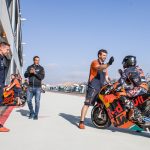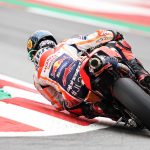Sachsenring marks the midpoint of the 2016 season, the ninth of eighteen races this year. Heading to Germany, Marc Marquez leads the MotoGP championship with an advantage of 24 points over his nearest rival, Jorge Lorenzo, while Valentino Rossi is 42 points behind the Repsol Honda rider. With ten races to go, and 250 points still to race for, the championship still looks fairly open. On paper, there is everything still left to play for.
In practice, the championship never seems to play out that way, however. A glance through the record books shows that the leader after eight races invariably goes on to win. Going back over previous years, I got all the way to 1998, and still found only one season in which the rider heading the title chase after race eight does not go on to become champion. The one exception? Valentino Rossi led Jorge Lorenzo by ten points after Assen last season, and ended up losing to Lorenzo by just five points. But the 2015 term was unusual in any number of ways, most especially the last two races. Whatever your view of the causes, and who is to blame (and by now, your view is probably as immutable as the laws of physics), the events at Sepang changed the course of that contest. Rossi went into the penultimate race of 2015 leading by 11 points, and still with a shot at the title.
The list of championship leads is instructive, and surprisingly representative of the outcome of that particular season. In 2014, Marc Marquez’ lead over Dani Pedrosa and Valentino Rossi was 72 points, and 2014 was a Marquez whitewash. The same is true of Rossi in 2005 and 2002. The Italian led Marco Melandri by 79 points in 2005, and Tohru Ukawa by 87 points in 2002, with Rossi dominating both seasons. In years where the title race was much closer, so was the points difference after race eight. In 2013, Marquez had a tiny lead of just 2 points over teammate Pedrosa, and led Lorenzo by 11 points. The title went down to the final race of the season that year. In 2009, Rossi led Lorenzo by just 9 points after eight races, and had to fight his teammate hard to clinch his seventh premier class title.
Then there are the surprises, the seasons that turn out to be very different from our memories of them. The abiding memory of 2008 for most fans was of Valentino Rossi turning the season around with a legendary victory over Casey Stoner at Laguna Seca. Yet three races earlier, Rossi led Casey Stoner by 45 points, with Dani Pedrosa trailing Rossi by 11. Rossi did put an end to a Stoner charge at Laguna Seca, but he still led the Australian by 20 points going into that race.
What will 2016 turn out to be? History says that the leader after eight races goes on to be crowned champion, and so far this year, Marc Marquez has barely put a foot wrong. He has won races when he could, but more importantly, learned to settle for second or third when he couldn’t. That was the bitter lesson of 2015, when Marquez tried to override an improbably bad Honda RC213V. By the eighth fixture of 2015, Marquez had already racked up three DNFs, all of which were his own fault, and he was 74 points down on Valentino Rossi. This year, that has happened only once, Marquez sliding out of the Le Mans race, but then remounting to come home in thirteenth and score valuable points.
Yet 2016 does not look like being a normal year. The spec electronics and more particularly, the switch to Michelin tyres have had a massive effect. Valentino Rossi is known as a rider who does not crash very often, yet he has already slid out of two races after asking too much of the front tyre. Jorge Lorenzo did something similar in Argentina, washing the front pushing to catch up to the leaders. Both Yamaha men have suffered misfortune through none of their own fault, Rossi having an engine blow up on him at Mugello, and Lorenzo being taken out by Andrea Iannone at Barcelona.
So 2016 looks destined to be a year in which weird things tend to happen. Marquez may not have crashed out so far this season, but if the Yamahas go on a run in the second half of the year, he may feel pressured into taking more risk than he has done so far. There are some real danger spots too, most notably the tracks where Bridgestone have previously brought an asymmetric front tyre. The Sachsenring and Phillip Island are the most obvious of those, with Turn 11 in Germany, and Honda and MG corners in Australia the most treacherous of the lot. In both cases, the danger is the same: bikes spending a lot of time on one side of the tyre, before having to be flicked over in the opposite direction on a front compound which is a little too hard and has a little too much time to cool off. Add in the still slightly vague feedback from the Michelin fronts, and you have a trap waiting to be sprung.
There are other factors in play here too. Jorge Lorenzo’s departure to Ducati has left him a little isolated in the factory Yamaha team, the vibe around him less focused than before. Valentino Rossi is riding better than ever, but bad luck and an overriding ambition has seen him make uncharacteristic mistakes. Marquez is riding very maturely, but a lack of progress at the recent Barcelona test has left him a little frustrated, and Honda is still unable to fix their problems with the RC213V’s engine. The factory Suzukis and factory Ducatis are becoming more of a spoiler, with Maverick Viñales and Andrea Iannone threatening to start taking podium places and possibly even wins from the top three. And if Michelin bring a rear tyre with a bit more grip, then Dani Pedrosa could come back into contention again.
On paper, based on looking back at history, Marc Marquez should be able to pencil his name on the MotoGP trophy for 2016. Of course, races aren’t run on paper, but on asphalt race tracks. And out there, anything can happen.








